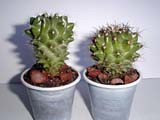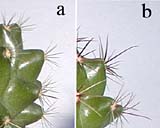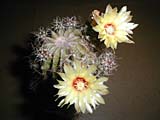Three cases in cultivation of Hamatocactus setispinus
Sergey Lyaschuk, Donetsk (Ukraine)
Translated by author
Donetsk Cacti & succulents club “Islaya”

Photo 1. The new monstrous form (Hamatocactus setispinus f. monstrosa cv. “Microsha”)

Photo 2. Hamatocactus setispinus (on the left - abnormal plant, on the right - normal of the same age)

Photo 3. The spines of Hamatocactus setispinus (a - abnormal spines, b - normal spines)

Photo 4. Flowering of Hamatocactus setispinus with a cut-off apex
| | | |
Case 1. In 2003 while inspecting a small seedling (3-4 mm) of H. setispinus I noticed several buds which withered though soon. Instead in their places there appeared drops of nectar and later still several offsets. The seedling was repotted to a personal plastic jar and was regularly examined. Soon it became clear that it is a new monstrous form (Hamatocactus setispinus f. monstrosa cv. “Microsha”).
It has a characteristic growth script: small flower buds are forming in areoles, later the buds die off and instead offsets begin to grow (measuring in diameter 5-7 mm) and so on. Such type of monstrous form is defined by Dr. Igor Skulkin as “micro-monstrosity” (see Cultivar N1 (11), 2002). In summer of 2005 there were up to ten buds on the plant simultaneously but they unfortunately never developed to flower. As to the spines they are absolutely untypical for H. setispinus, looking like bunches of short bristles (photo 1). In 2006 I’ve been propagating this form by grafting: 5 offsets were grafted onto Echinopsis hybr., later three specimens were distributed among members of our C&S club "Islaya". Grafted offsets grow very fast.
Separated offsets root easily; they often begin developing roots while still attached to the mother plant. As to the mother plant, in 2006 it brought new surprises for me. Further to already described, there appeared offsets of other types: 1) without spines and with naked areoles; 2) without spines and with small white areoles; 3) a red-colored offset without spines, but with areoles densely covered by yellow or orange felt. In 2007 I’m going to continue propagating these forms.
Case 2. Among seedlings of 2003 there was a form with light-colored short spines (photo 2, on the left - abnormal plant, on the right - normal of the same age). The central spine is straight, not hooked and short, not differing in length from the others (photo 3: a - abnormal spines, b - normal spines). The stem of the plant is elongated, ribs are not pronounced.
Case 3. I In spring of 2003 I cut off the apex of two unsightly specimens of H.setispinus aged 7-8 years, with the aim to cause offsets formation. Three weeks later alongside with offsets from some areoles there appeared flower buds. These buds grew to flower (photo 4) and set fruits and viable seeds. The most probable reason of this phenomenon is awakening of the “sleeping” buds that in due time didn’t produce flowers for some reasons. But I’m not through yet! One of the control plants formed two offsets near the cut edge, and these offsets measuring only 5 mm in diameter produced multiple small flower buds! The buds grew to flower (photo 5), and later I got fruits (photo 6) and seeds. The offsets located in the middle part of the stem produced no buds. Next year the offsets were flowering again, but there were no flowers from areoles on the main stem.





